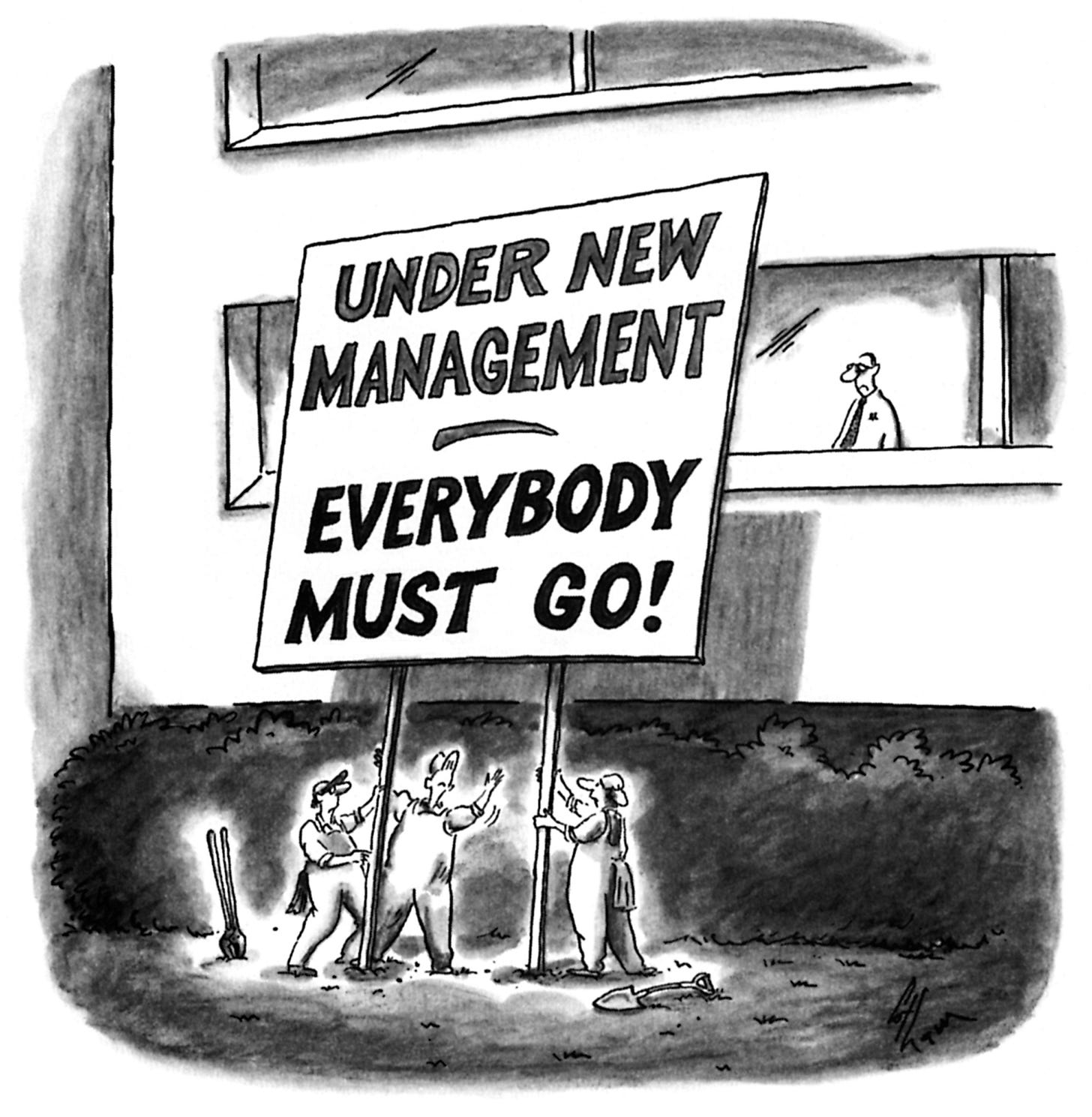The Urgent Case for Changing Creative Agency Remuneration before AI Destroys Man-Hour Billing
Creative agency services are valued today by "man-hours" of agency time. What happens when AI reduces man-hours by a factor of 10 or 100 or more? Good-bye man-hours! Good-bye agency revenue!
Credit: Frank Cotham, The New Yorker, The Cartoon Bank
Let’s imagine a client who wants its creative agency to complete a new scope of work for a product relaunch:
One TV:30 (original) plus 3 TV:15 adaptations and 3 TV:10 adaptations.
One original half-page Print Ad plus 10 adaptations.
A rich-media email marketing blast with 26 variations in each of 10 markets.
A Facebook campaign with 26 variations in each of 10 markets
The production will be handled by the agency, which is paid (generously) a blended average rate of $175 per hour for its people — a little less than the shop mechanic is billed out at Monroe Auto Service & Tire Center, just down the street from the agency.
The agency calculates that this scope of work will take the effort of 4.8 FTEs, or 8,644 man-hours to complete the delivery of these 588 deliverables for a fee of $1,512,683 (4.8 FTEs x 1,800 hours x $175 per hour), and these figures are submitted to the Procurement folks, who have to cut a PO to authorize payment for this new SOW:
3,094 creative man-hours $541,453
2,475 client service man-hours $433,162
619 strategic planning man-hours $108,291
2,456 production man-hours $429,778
8,644 total man-hours for a fee of $1,512,683
Procurement reacts as follows:
“Our internal agency has been working with an AI vendor, and we experimented by running this same scope of work through their program.
“On a man-hour basis, using AI, they can conservatively cut the man-hours for these deliverables to 1,400, a man-hour and fee savings of 84%.
“This would lead to a fee of $241,231 — considerably less than your estimate.
“Of course, there were certain quality problems with the AI deliverables, requiring a lot of tweaking by our staff, but even with this requirement, we don’t see why this should cost us more than $500,000 or so in a future AI environment.”
******************************************************
Creative agencies can ill-afford to be trapped by valuing their work by man-hours.
Instead, creative agencies need to charge “for the scope of work,” putting a value on the work…and ensuring that the scope, as conceived, “adds value” to deliver brand growth or other measures that are valued by their clients.
What is the value of a successful relaunch of the client’s product? It is probably millions of dollars. Agencies need to do the calculations to know this value, and also to have a point of view about the quality of the scope that the client wants to implement.
If the agency has doubts about the quality of the scope, then it should propose a better scope.
The agency should then use the ScopeMetric® system to measure the “size and weight” of the creative scope of work, which lends itself calculating the price of the entire scope.
What does ScopeMetrics® tell us about the proposed scope of work?
There are 588 deliverables in total, of which 22 are original pieces of work and 536 are adaptations of the original work.
The entire scope adds up to 8.6 ScopeMetric® Units (SMUs) of work. (An SMU is roughly the size of a typical TV original spot. Think of the SMU as if it were a “kilo” — a measure of size or weight. The SMU is described in Madison Avenue Manslaughter, published in 2019).
A reasonable price for an SMU today is about $176,000 (down from $435,000 in 1992, when it was first invented for Ogilvy and subsequently used in analytical work for Grey, McCann, FCB, BBDO, TBWA, DDB, Leo Burnett, Saatchi & Saatchi, Hershey, Ford, Toyota, Kraft, American Express and many others).
On this basis, at $176,000 per SMU, the proposed scope would have a price tag of about $1.5 million, which is probably a fraction of the benefit to be realized if the brand relaunch is successful.
Procurement will always have leverage over agencies if they continue on calculating agency fees on the basis of some estimate of man-hours.
Bear in mind that Apple does not let us buy iPhones based on Apple’s man-hour costs in China, or India. An iPhone has a price, as do all other products in the world…except for creative agency outputs.
Agencies need to urgently change the nature of the fee-setting game before they see their income stream disappear.




I absolutely get this, but have yet to see it in practice. This is an industry level change that needs to happen, but I’ve no idea how. An agency pricing their output on value against others on hours will be unpalatable when compared side by side.
Also calculating the value is incredibly difficult, especially when clients can be so bad at understanding and reporting the value and impact of the work anyway.
So yes agree, pricing on hours isn’t right. But I can’t see how value based pricing can work either. Would love to hear, or discuss more with people on alternative methods and pricing models.
Hi Michael, hope you're well. Of course I agree and the reckoning has come for time-based pricing, although many agency bosses might say the clients have set the trap via procurement i.e. if we don't bill man-hours, we can't be benchmarked and therefore you won't consider us for pitch.
Anyway, I would hope that a modern "creative agency" would reimagine its future as divorced from production, which may have returned a nice margin for decades but is being upended by gen-AI tools which will only keep improving.
This is my bias as a words guy, but the clues are in the name: "creative" vs "production".
Creative (the unpredictable) --> value-based pricing, based on talent and experience to give an advertiser the ultra high-quality marketing consultancy that should be expensive and more than pay for itself in increased sales
Production (the predictable) --> rinse-and-repeat tasks that will be automated and robotised, overseen by great craftspeople
Does this mean "creative agencies" of the future will emulate BBDO or Ogilvy? No.
Would it make them more valuable? I'd argue, yes.
And the more valuable you are, the more I have licence to go back to people like Monroe's Tyres and say "hey man, it costs what it costs. Go with your yes-man colleagues and their budget AI tool if you want, and let's see what happens to your sales."